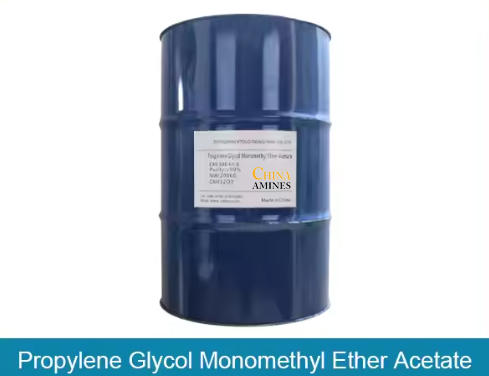1. Chemical Structure and Properties
Molecular Formula: C₆H₁₂O₃
Structural Formula: CH₃COOCH₂CH(CH₃)OCH₃ — A glycol ether ester derived from propylene glycol monomethyl ether (PGME) and acetic acid.
Physical Properties:
Appearance: Clear, colorless liquid with a mild ester-like odor.
Boiling Point: 146–152°C; Density: 0.97 g/cm³; Vapor Pressure: 0.3 mmHg at 25°C.
Solubility: Miscible with most organic solvents (ethanol, acetone); slightly soluble in water (4.7 g/L at 20°C).
Chemical Properties:
Polarity: Balanced hydrophilic-lipophilic nature (log P: 0.2).
Reactivity: Hydrolyzes under strong acidic/alkaline conditions; stable in neutral environments.
Flammability: Combustible liquid (flash point: 47°C).
2. Industrial Applications
Semiconductor Manufacturing:
Photoresist Solvent: Primary carrier for photoresists in EUV and DUV lithography (e.g., ASML’s 5nm node process).
Edge Bead Removal: Cleans residual photoresist from wafer edges.
Coatings & Inks:
High-Performance Solvent: Enhances flow and leveling in automotive and industrial coatings.
Flexographic Inks: Reduces viscosity for improved printability.
Electronics Cleaning:
Flux Remover: Cleans solder residues in PCB assembly without damaging components.
Pharmaceuticals:
Reaction Medium: Solvent for API synthesis and crystallization processes.
3. Safety and Toxicology
Health Hazards:
Acute Exposure:
Inhalation (≥50 ppm): Irritates respiratory tract; dizziness (TLV-TWA: 50 ppm).
Skin Contact: Mild irritation (rabbit skin LD₅₀: >2,000 mg/kg).
Ingestion: Low toxicity (oral LD₅₀ rat: 3,500 mg/kg).
Chronic Effects:
Reproductive Toxicity: No evidence of teratogenicity (OECD 414 compliant).
Neurotoxicity: Minimal risk with proper ventilation.
Protection Measures:
PPE: Nitrile gloves, vapor respirators, chemical goggles.
Storage: Inert containers away from oxidizers and heat sources.
4. Environmental and Regulatory Compliance
Environmental Impact:
Aquatic Toxicity: LC₅₀ (fish, 96h): >100 mg/L; EC₅₀ (daphnia): >50 mg/L.
Biodegradability: Moderate (OECD 301F: 60% degradation in 28 days).
Atmospheric Fate: Reacts with hydroxyl radicals (half-life ~24 hours).
Regulatory Frameworks:
EU:
CLP Regulation: Classified as Flammable Liquid (Category 3), Eye Irrit. 2 (H319).
REACH: Registered with SDS requirements for occupational exposure limits.
USA:
OSHA PEL: 50 ppm (8-hour TWA); EPA: Exempt from VOC status under certain conditions.
China:
GB 13690-2009: Listed as Hazardous Chemical (Class 3.3).
Transport:
UN Number: UN 3271; Hazard Class: 3 (Flammable Liquid), Packing Group III.
5. Case Studies and Application Insights
Case 1: EUV Lithography in Semiconductor Fabrication:
Application: TSMC uses PGMEA in ASML EUV scanners to pattern 3nm node chips.
Performance: Achieves linewidth resolution<15nm with 99.9% solvent purity.
Case 2: Automotive Clearcoat Formulation:
Process: PPG Industries replaced toluene with PGMEA in UV-cured clearcoats for Tesla vehicles.
Result: 30% lower VOC emissions while maintaining gloss and adhesion.
Comparative Analysis:
PGMEA vs. Ethyl Lactate:
Pros: Higher thermal stability, better compatibility with epoxy resins.
Cons: Higher flammability vs. ethyl lactate’s higher flash point (53°C).
Specifications:
Our PGMEA is a colorless, low-boiling (146 °C) glycol ether acetate with ≥99% purity, density ~0.97 g/cm³, outstanding solvency for inks, coatings, and cleaners, rapid evaporation, and low VOC emissions.


